
Accounting for project-based businesses can be particularly challenging for inexperienced financial managers since there are far more considerations than just capturing revenue and expenditures on an income statement. A simple but accurate financial statement presentation may be acceptable for many outside parties, but management’s ability to use these reports to make informed decisions is determined by how the person doing the accounting work accumulates and allocates costs. Let’s look at a few examples with the same bottom line:
In this simple format, whatever we bill we count as revenue and vendor invoices that come in during the period are counted as expenses. There’s not a lot of information except we know we didn’t make any money.
| Billings | 2,100,000 | |
| Expenses | 2,200,000 | |
| Net Income | (100,000) |
Taking it a step further we decide to break down our expenses by what we know are project costs (labor, material, etc.) and overhead expenses. We may also decide that our project revenue is not billings, but a percentage of the contract that has been completed. In any case, we can now see that the projects are making some money, but perhaps our overhead is too high. This step also allows us to determine if the margin on our projects is in the acceptable range. If too low, management can determine the cause; whether it’s underpricing the job or cost overruns. Asuming our overhead expense isn’t excessive, the conclusion drawn from this is: we need more work.
| Project Revenue | 2,100,000 | |
| Project Costs | 1,800,000 | |
| Gross Profit | 300,000 | |
| Overhead | 400,000 | |
| Net Income | (100,000) |
Now let’s take a more detailed look at our overhead expenses. We have rent, utilities, salaries, but there are also expenses such as project management and salesperson salaries and benefits, small tool purchases, consummables to stock the warehouse or trucks, etc. Many of these are job-related, but not specific to one project. Tools, for example, we purchase and they may last for several years. If we could come up with a formula to charge these expenses to projects then the financial statement could look quite different. In this example, after allocating these costs we find that our margin on the actual jobs is zero. Now management can start figuring out what caused this.
| Project Revenue | 2,100,000 | |
| Project Direct Costs | 1,800,000 | |
| Project Indirect Costs | 300,000 | |
| Gross Profit | – | |
| Overhead | 400,000 | |
| Indirect Costs Allocated | (300,000) | |
| Total Overhead | 100,000 | |
| Net Income | (100,000) |
Note that we have introduced two descriptions for costs of goods sold: direct and indirect. Direct Costs are expenditures that relate to the production of revenue but can be allocated to a specific job. Examples include materials, labor, rental equipment, etc. Indirect Costs still relate to producing revenue but are not easily allocated to a specific job. Examples include saw blades, gloves, fuel, or workers compensation insurance.
Imagine how time-consuming it would be to break a cell phone bill down by job. In other cases, such as vacations and holidays, timing differences make direct costing difficult or impossible. We can’t charge a job foreman’s vacation pay to the project he happens to be working on, so it goes to overhead, but ultimately it should really be a project cost. In a perfect world, our goal is to allocate every penny of cost to a project but that just isn’t practical. Therefore, most accounting professionals make every attempt to directly identify as many costs as possible and have a method to allocate the remaining indirect costs. A good cost allocation methodology will come very close in determining the true cost of a project.
In our next installment, we will talk about methodologies to allocate the indirect costs to continue advancing our goal of allocating as much as possible to specific jobs.



